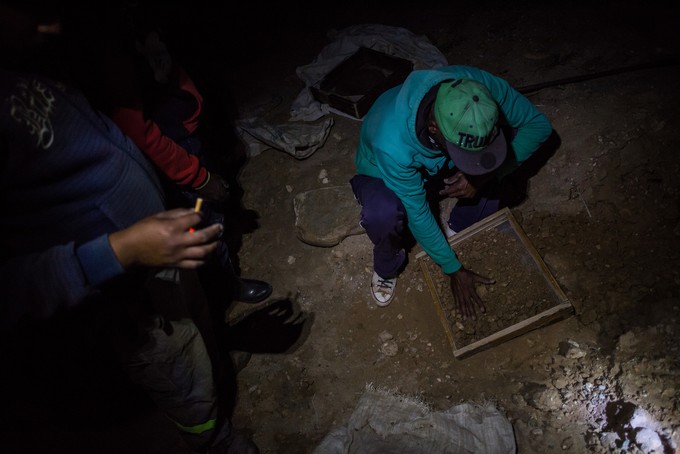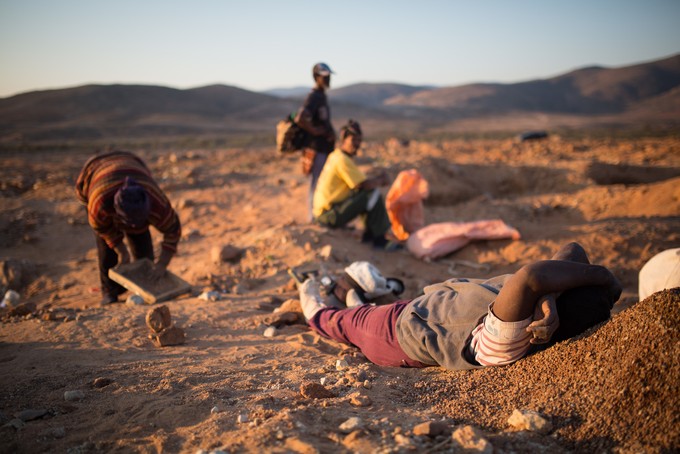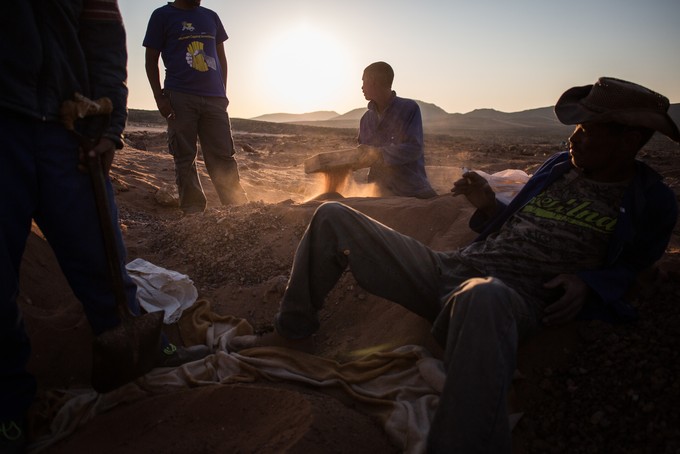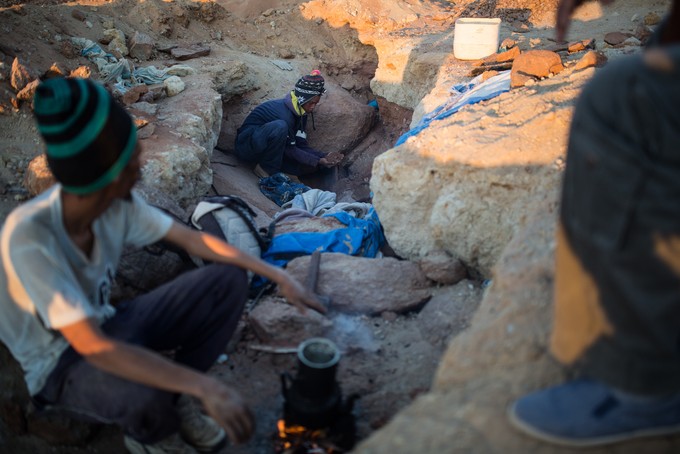Rough diamonds - part four: Illicit digging carries on
Miners are excavating new tunnels
Shortly before leaving Hondeklipbaai, where the decline of legal diamond mining has left a legacy of chronic unemployment, we accompanied three men on an illicit dig. We met up with them after dark, at the edge of the settlement. We walked hard through coastal shrub with our headlamps switched off. Lights from patrol vehicles flashed behind the dunes.
In the past, diggers from Hondeklipbaai targeted disused mines north and east of the settlement. One popular spot was called Absa; another, FNB. But the consortium West Coast Resources recently reopened these mines, tightening security and making access more difficult. Some diggers continued operating as before, entering restricted areas in spite of the increased risk — usually by bribing mine security guards, who earn less than R5,000 per month, diggers said. Others, like the men we had joined, shifted their attention to public land, where diamonds are less abundant, but working is safer.
We stopped on a flat platform, within earshot of the ocean. Shallow depressions dented the surface beside neat mounds of pebbles. The men dropped their tools: a spade, two sieves, some plastic sacks, and a long jackhammer chisel, or ‘gwala’. With their backs to Hondeklipbaai they switched on their torches. Then they spread a dirty white sheet on the ground and started to dig.

One of the men, Paul*, was 19 years old. He had been drinking since before noon, and hacked the ground with little precision. He gripped his chisel like a weapon, breathing heavily. As he loosened the gravel, one of his accomplices — tall, stooped, middle-aged — shovelled it into a sieve to remove the sand. The men then transferred this gravel into a coarser sieve and shook it out above the sheet, discarding the larger stones. When they had collected enough material they lifted the sheet and tipped it into one of the sacks.
On the walk from Hondeklipbaai, Paul had grown belligerent, issuing orders and goading the two older men. At one point, he threatened to leave with the tools; one of the men stopped him, almost leading to a fight. But as Paul worked he became calmer, and by the time the men carried their gravel down to the shore he was focused on completing the task.
He bent above a rock pool to rinse the gravel. The water turned brown as he shook the sieve. He knocked the sieve from side to side, settling the gravel. Then he carried the sieve to a shelf of clean stones a short distance up the beach.
“Dolomond!” he cried — the word Namaqualanders use for diamonds. In a smooth movement he tipped the sieve upside down and emptied it onto the shelf. His shaking had drawn the heavier material towards the centre of the sieve. It was darker in colour, forming a distinct circle inside the wet gravel square. Diggers call this circle the ‘kol’. When diamonds are present they appear right in the middle, like bullseyes. Paul dropped to his knees and began inspecting the rough, his nose centimetres away. He repeated the process four times, but found nothing.
Walking back to Hondeklipbaai, Paul spoke about his older brother, who was stabbed to death this January. “I feel messed up,” he told me. “I want to hurt people. I want to kill people.”
“He’s crazy,” one of the older men added. Paul had recently stabbed Sidney, one of the diggers who survived the Bontekoe collapse, in the cheek and back, “for no reason.”
“Something is wrong,” Paul told me. “I get mad and can’t control it.”
The moon had turned deep red and slipped over the horizon. It was Paul’s brother’s birthday, the men announced; he would have turned 21 that morning. His mother had visited the grave with flowers that afternoon. Paul hadn’t joined her, but sat at the harbour, drinking.

The next morning, we drove to Komaggas, where an estimated 90% of households once depended on the diamond mines for employment. It grew hotter as we drove inland. By the time we arrived, the temperature exceeded 30 degrees. At a meeting in the community hall, representatives from four former mining communities — Komaggas, Hondeklipbaai, Buffelsrivier, Soebatsfontein — discussed plans to protest against West Coast Resources.
“For nearly 100 years, De Beers gave us job opportunities, but left nothing behind,” said a middle-aged woman named Juliana. “Now there’s a new company working here. We’re going to make sure they meet our demands.”
West Coast Resources had promised to employ local people but then “brought outsiders in from other mines,” a man from Buffelsrivier said. “There have been many empty promises.”
On its website, the company predicts creating 200 jobs by June 2016, and a total of 550 jobs by 2021. By August 2015, the company had received more than 3,500 CVs from applicants. The company stated its “[commitment to] employing local candidates, especially previously disadvantaged individuals, women and the youth,” in an April 2015 newsletter. To date, the company has hired two people from Hondeklipbaai, according to residents. West Coast Resources declined to answer written questions and referred me to “public knowledge” on their website.
“We can talk about work,” said one of the men at the meeting. He had recently become a local organizer for the Economic Freedom Fighters (EFF). “But we must discuss ownership. This land is ours. The government should give us the chance to mine certain areas ourselves.”
South Africa currently has no legal framework to support artisanal or small-scale diamond mining, despite claims on the Department of Mineral Affairs (DMR) website that the government is “working to legalise the small-scale mining operations that currently exist, and find ways to help make them economically viable.”
An investigative hearing by the South African Human Rights Commission (SAHRC), conducted in 2013, reported that “artisanal mining is not legally recognised, despite its growth and the potential opportunities it offers, economically and socially.”
With up to 30,000 informal miners working illegally across the country — mainly targeting diamonds and gold — the SAHRC hearing concluded that the sector “cannot be ignored … particularly [in a context of] poverty, unemployment, inequality, and unevenly enforced regulations.”

After the meeting, some men took us to the ‘digveld’, a pitted expanse of land, littered with trash, in an old strip-mine near Bontekoe. People peered from the crest of a mine dump as we approached, preparing to run. The men shouted from the vehicle — “It’s safe! They’re with us!” — and guided us through drifts of sand to the site. Sunset was approaching; the air had cooled. More than 40 people clustered in groups around crumbling metre-deep holes.
A tiny, wrinkled woman in a pink church hat and fleece jacket stood back from one of the diggings, where her son and six other men were sifting piles of gravel. Her husband, a thin 70-year-old with raised veins on his arms, waited at her shoulder. She told me that they had been camping in the veld for seven days, sleeping in a ‘khaya’ — a low tent made of branches, blankets, and plastic sheets — in a nearby riverbed.
“Our food is finished. We’re driving back to Komaggas tonight,” she said. “Our petrol is low; we don’t know if we’ll get home. But we can’t carry on.”
They had found no diamonds that week, she said. “We have no other income besides my husband’s pension of R1,500 per month. We’ll come back as soon as we can afford another trip.”

A short distance away, three middle-aged women sat at the edge of a pit, knocking chisels into the earth and rinsing stones in a plastic drum. One of the women was from Cape Town; she told me she’d once worked as a cleaner at the Silver Spur in Bellville.
“I have three adult children. None of them have jobs. One of the grandchildren lives with me in Komaggas now,” she said. “If I find anything, I send the money home.”
She had found no diamonds after digging for eight consecutive days, she said. At most, she hoped to earn R1,800 for a single stone, splitting the money with her two companions.
We left the diggers and drove deeper into the mine. In an abandoned, unvegetated trench, lit orange by the fading light, we came across a Rasta elder with a posse of younger men. They had been excavating tunnels for almost two weeks, the Rasta said. They hoped to reach the gravel layer within the next few days.
He took us to the entrance of the deepest tunnel, which dropped ten metres through hard sand. One of the men swung into the tunnel and descended like a spider, his feet finding crevices chipped into the mud. When he reached the bottom, he gazed up, dwarfed by the shaft. The Rasta said that they would dig horizontally for at least fifteen metres from where the man stood.
“As soon as we find diamonds, people will start coming, just like at Bontekoe,” he said. “That’s when the fights will start.”

The Rasta spoke from experience. In 2012 he excavated the tunnels at Bontekoe, working alongside thirteen other men. “We prospected that area before digging, just like geologists,” he told me. “We kept working when the crowds arrived. We kept control of that place for a few weeks but then it became impossible. People started carrying jackhammers in.”
The Rasta left Bontekoe three days before the tunnels collapsed, when he saw cracks spreading across the ceiling. Dust had already started to fall. Diggers at the surface swore at him when he warned them not to go inside; he gave up arguing and walked away. Since then, he has opened “many” other tunnels, he said. He prays each time he crawls below ground.
Bontekoe was no deeper than any of his newer tunnels. It was no less secure. A mine collapse seems no less likely four years later. We visited the Bontekoe site a few days before meeting the Rasta; it was silent, in a basin below red dunes and heaps of mining debris. There was no trace of the old tunnels, only compacted sand with the fading imprints of bulldozer tracks. Clumps of chalk scattered the surface where the area had been filled in. They gave the ground a slightly paler colour. Rubbed together, they produced a white dust that scattered in the wind, like salt.
Support independent journalism
Donate using Payfast

Don't miss out on the latest news
We respect your privacy, and promise we won't spam you.
Letters
Dear Editor
De Beers is probably correct when they say they have acted always in line with the law. It is a pity the Department of Mineral Resources did not comment. But it seems that the Bontekoe accident did not take place in a mine as defined by the Mineral and Petroleum Resources Development Act. (This is why the editor had such a problem understanding the words of the De Beers respondent). The DMR only has jurisdiction over mines – which are places where mining rights or permits have been issued for the mine. The DMR acts as an advisor to the police when mining takes place without the required licences and permissions. In many cases the law can only charge illegal miners with trespassing. In early 2014, Judge Jake Moloi of the Free State Supreme Court case called on Parliament “to enact a law that will have harsh punishment for ... illegal [mining] activities which are assuming horrendous proportions.” (Mugota v S (A244/2013) [2014] ZAFSHC 25 (13 March 2014).)
This will not address the socio-economic problems illustrated in the article. But it might provide firmer ground for the condemnations of the DMR by the SA Human Rights Commission, which also appears to misunderstand what the mining law administered by the DMR covers.
© 2016 GroundUp. All rights reserved. (Note this article is not published under the Creative Commons license that we usually use.)

